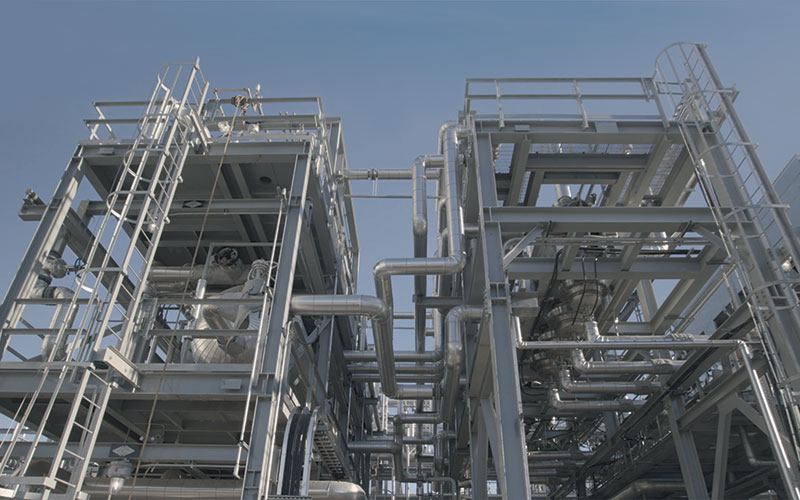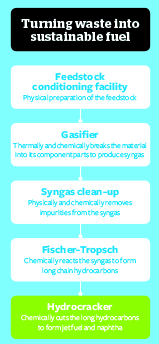Renewable jet fuels take off
While the uptake of sustainable alternative fuels in the aviation sector is still in its infancy, Velocys is one company that is helping the UK move closer to developing its first waste-to-renewable jet fuel plant, writes Neville Hargreaves

The global aviation industry emitted 859m tonnes of carbon dioxide in 2017 – 2% of all CO2 emissions1. According to a report by the Roundtable on Sustainable Biomaterials, ‘Greenhouse gas emissions from global aviation have more than doubled over the last 20 years… Demand for aviation fuel will grow by approximately 1.5–3% per year to 20302.’
As a result, in 2009 the airline industry committed to carbon-neutral growth by 2020 and a 50% reduction on 2005 emissions levels by 2050. After six years of negotiations, the International Civil Aviation Organisation agreed on a global mechanism for aviation to deliver carbon neutral growth: the Carbon Offsetting and Reduction Scheme for International Aviation (CORSIA). CORSIA will be the first market mechanism for dealing with climate change from any industrial sector. Sustainable fuels will play a part in airlines’ methods for meeting their CORSIA obligations. Since 2008, more than 100,000 commercial flights have flown on some blend of biofuel, and the industry has recorded more than 4m tonnes of offtakes of renewable fuel2.
By 2022 there is expected to be a worldwide demand for more than 6m tonnes per year of renewable jet fuel based on carbon neutral growth.
A new plant
Velocys, a renewable fuels company, is working to develop the UK’s first commercial scale waste-to-renewable fuels plant, with the support of British Airways and Shell. This plant would take hundreds of thousands of tonnes per year of residual waste left over after recycling, destined for landfill or incineration, and convert it into clean-burning, sustainable fuels for aviation and road transport. The project team is developing the engineering and business case for the project, which is also subject to planning consent, funding and a final investment decision.
The first plant would require several hundred million pounds of capital. It could enter construction during 2020, creating hundreds of construction jobs and 50 to 100 direct long-term skilled jobs.
 How it works
How it works

This plant will use waste that cannot viably be recycled, to produce a fuel that displaces the consumption of fossil-based fuel and its associated CO2 emissions. The project is taking proven technologies and combining them in a new way to deliver a cost-effective supply of renewable fuels.
A simplified version of the process is shown on the left. The incoming waste is sorted and prepared to enter the gasifier, where it is heated to a high temperature to break it down and convert it into synthesis gas (or syngas) composed mainly of hydrogen and carbon monoxide. After removal of contaminants, the syngas is used in the catalytic Fischer-Tropsch synthesis to make hydrocarbons, which are then hydrotreated and separated into synthetic paraffinic kerosene (approved worldwide for commercial aviation at up to 50% in a blend with conventional jet fuel), and naphtha (a constituent of petrol). All these steps use commercially proven technology, but the combination is novel; integration will be one of the key risks for such a project, which needs to be mitigated using a combination of technical and financial approaches.
Environmental impacts
The jet fuel produced from the biogenic fraction of the waste is expected to deliver over 70% greenhouse gas reduction, compared with fossil fuel3. It would also deliver local air quality improvements around airports. Studies on jet aircraft using fuel made by the Fischer-Tropsch process have shown up to 90% reduction in particulate matter emissions, nearly 100% reduction in sulphur oxides, up to 40% reduction in carbon monoxide and up to 10% reduction in nitrogen oxides. In addition, operation of the plant would prevent several hundred thousand tonnes of non-recyclable waste from going to landfill each year.
 Status and support
Status and support

In June 2018, the project received £4.9m of funding for the current development phase. This includes a grant of £434,000 from the Department for Transport under the Future Fuels for Flight and Freight Competition (F4C). The project will also benefit from the policy support of the Renewable Transport Fuel Obligation (RTFO), now with a category of Development Fuels giving extra incentives to the hard-to-decarbonise aviation sector. These incentives are important in the short term for getting new technologies such as this established in the market. However, the project has a balance of revenues between waste gate fees, fuel sales and credits under the RTFO.
In December 2018, the project secured a site near Immingham, North East Lincolnshire.
Outlook
Projects such as this could be a key part of a flourishing bioeconomy in the UK. The country could create an industry for the production of sustainable fuels worth up to £250m per year in 2030, supporting up to 4,400 high quality jobs in the UK4. This industry, built on British innovation and intellectual property, has the potential for global export.
By Neville Hargreaves, Vice President – Waste-to-Fuels, Velocys
References
1. Air Transport Action Group (2018) Facts and Figures. Available at www.atag.org/facts-figures.html
2. The Roundtable on Sustainable Biomaterials (2018) Alternative Aviation Fuels. Available at www.rsb.org/wp-content/uploads/2018/09/RSB-Alternative-Aviation-Fuels-A-Sustainable-Future-is-Taking-Off.pdf
3. Based on independently reviewed life cycle analysis using assumptions approved for the F4C
4. Sustainable Aviation (2018) Sustainable Fuels UK Road-Map. Available at www.sustainableaviation.co.uk/wp-content/uploads/2018/06/SA-SAF-Roadmap-FINAL-24-Nov-2.pdf






Follow us
Advertise
Free e-Newsletter